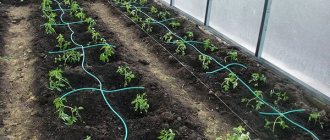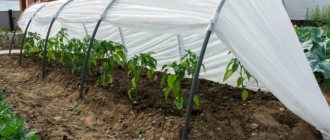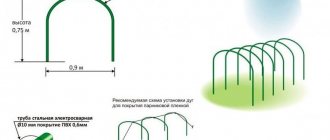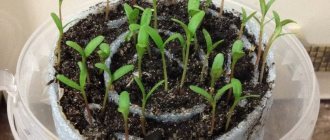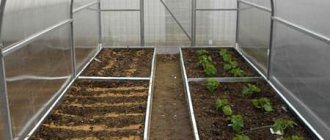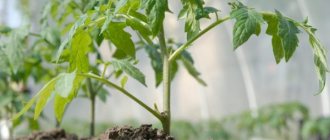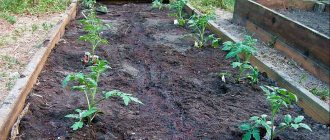Often, even with proper care, tomatoes become rotten and do not produce ovaries. And all because during planting the required distance is not maintained between the bushes. We present clear schemes for planting tomatoes so that you get a good harvest.
Last year, the seedlings suffered from crowding, was it inconvenient to care for the plants and harvest? To avoid these mistakes, you need to know at what distance to plant tomatoes, and adhere to these rules when planting in a greenhouse and open ground.
Planting by eye is used when there are few plants - 10-15 bushes. In other cases, you must definitely arm yourself with a centimeter, pegs and ropes to mark the planted area. You can also make a marker from a board that will make it easier to mark the holes.
- 17 best varieties of tomatoes for greenhouses and open ground – rating from our readers
What varieties of tomatoes are most loved by tomato growers? You will learn about this from our material.
How does the distance when planting between tomato bushes affect growth and fruiting?
The growth of the bushes and their fruiting will depend on how close to each other you plant the tomatoes.
Tomato bushes are growing quite strongly. If they do not have enough space, they will not be able to form shoots on which fruits will grow.
What happens when tomatoes are planted thickly?
Tomatoes are a crop that loves space. Unlike, for example, peppers, which, on the contrary, prefer a denser planting.
If you plant plants too close to each other, they will begin to interfere with each other. The fact is that tomatoes grow strongly and form new shoots. This is necessary for abundant fruiting and the formation of the fruits themselves.
When tomatoes sit too long, they have no room to grow. As a result, the harvest is meager, and the bushes themselves often get sick, since their immunity is weakened.
In addition, plants sitting nearby begin to compete with each other for sunlight, micronutrients in the soil, etc.
Also, dense plantings are dangerous due to the rapid spread of fungal diseases and massive pest damage.
If tomatoes are planted too far apart
If you plant tomatoes in open ground, leaving a lot of free space between the bushes, then nothing bad will happen. Plants will develop normally.
But the problem will be different. Namely, in the irrational use of site space. You shouldn’t expect tomatoes to grow to the size of berry bushes. Therefore, they need to be planted in the most optimal way.
In addition, by leaving a lot of space between the bushes, you doom yourself to weeding.
Also, the “empty” land will dry out, which in the future can lead to soil erosion.
Square-cluster planting pattern
The square-cluster method of planting vegetables was especially popular in Soviet times under irrigated farming conditions. But this planting scheme remains relevant to this day.
The distance between the nests in the transverse direction is 80 centimeters; a furrow for irrigation will be located here. In the longitudinal direction, the distance between the nests is 60 centimeters. Each nest contains from one to 3 bushes. If you plant 3 plants, then during the growing season the weaker sample can simply be removed.
It is advisable to use the square-nest method where not manual, but mechanized agricultural technology, and in some cases even harvesting, is expected.
Schemes for planting tomato seedlings
Exactly how to place tomatoes in your garden depends on how much space you can allocate to tomato beds, as well as other related factors.
For example, if the vegetable garden covers the garden on one side, then it is better to plant tomatoes in a row. If, on the contrary, the area is open, then it is better to place the tomatoes compactly and so that they are easy to care for.
The most popular schemes for planting tomatoes in open ground are below.
Parallel landing scheme
In fact, this is not one scheme, but a whole group of schemes for planting tomatoes in open ground, the essence of which is to plant plants in parallel in rows at an equal distance from each other.
Usually, 2 rows are made side by side with a distance of 50 cm between them, then a passage about a meter wide and again 2 rows. This paired arrangement is dictated by the need to care for tomato bushes.
ON A NOTE. The specific distance between tomato bushes in open ground is determined based on the size of the variety. Tall ones are planted less often, short ones more often.
By the way, when planting in parallel, it is better to plant the bushes from west to east, so that the sun evenly illuminates the plant throughout the day.
Checkerboard landing pattern
The checkerboard method is used for planting low-growing and low-growing varieties in open ground. It is also good for limited space or when you are planting in a specific area due to crop rotation.
With this scheme, you first determine the size of the area where you will plant tomatoes and dig holes so that there is 40-50 cm between adjacent holes.
The advantage of this scheme is the compact arrangement of tomato bushes.
Planting in raised beds
Some summer residents make high, warm beds for the convenience of caring for tomatoes in the open ground. In one bed, 2 rows of seedlings are placed with a distance of 50 cm between the bushes. Leave 70 cm between rows.
The advantage of this scheme is the ease of caring for tomato bushes.
How to choose a place for a tomato bed
Tomatoes are sensitive to growing conditions - this is due to the subtropical origin of nightshade crops. On the site for the tomato bed, you should allocate a well-drained sunny area, protected from the wind.
It is extremely undesirable to plant tomatoes in the same place again, as after any nightshades - potatoes, peppers, eggplants. It is necessary to wait 2-3 years to reduce the likelihood of an outbreak of infections whose spores remain in the garden.
The best predecessors for tomato culture are onions, garlic, carrots, cucumbers, all legumes or green manure, which improve the health of the soil.
When choosing a place for a tomato garden, you should also take into account nearby neighbors in the garden.
- Do not place tomatoes next to potatoes. In addition to diseases, they have a common pest - the Colorado potato beetle.
- Experienced summer residents know that marigolds and calendula not only decorate the site. Planted along the edges of the beds, flowers repel insect pests. Phytoncides of fragrant plants resist outbreaks of late blight and other fungal diseases of tomatoes.
At what distance from each other to plant tomatoes in open ground, popular schemes
When planting tomatoes in open ground, it is important to choose the correct distance between plants so that the bushes do not interfere with each other.
ON A NOTE. On average, the optimal distance between individual tomatoes is about 50 cm, and between rows 70-80 cm. More precise values depend on the characteristics of the particular tomato variety.
The choice of a specific landing scheme depends on several factors:
- Dimensions and shape of the site.
- Number of seedlings.
- Varietal characteristics of planted tomatoes.
There are several schemes. Let's look at the 2 most popular and effective ones.
Parallel landing
If you plant tomatoes in open ground in even rows using the strip method, then it is better to form beds 1 m wide. Leave 50-60 cm between rows in one bed, and maintain a distance of 100 cm between rows.
This method of planting will allow you to care for tomatoes very conveniently.
Leave at least 50 cm between individual bushes.
Chess scheme
On square plots, a checkerboard planting pattern is practiced. In this case, maintain 40 cm between individual bushes.
This model is good if you have few seedlings or are limited in space.
Also, planting using the checkerboard method is chosen if the area of open ground is poorly located, or, conversely, only it has a suitable type of soil.
Ordinary planting scheme
The simplest option for planning beds, understandable even to the most inexperienced vegetable growers. Suitable for low-growing, early-ripening varieties. Tomatoes are planted in rows maintaining a certain distance both between bushes and between rows. Before planting, it is advisable to make a marking, according to which you can then plant the bushes. You can plant tomatoes in an ordinary way, taking into account the following parameters:
- 60X25.
- 60X35.
- 50X70.
This scheme is more suitable for low-growing tomatoes and tall ones formed into one stem. The scheme is not very practical, as it takes up a lot of space, and carrying out agricultural techniques and harvesting is not very convenient.
At what distance from each other should different varieties be planted?
Summer residents often plant several varieties in their gardens. Some will be used for preparing light summer salads, others for pickling, others for preparing tomato juice, etc.
Each variety of tomatoes growing in open ground needs its own conditions for normal development.
Tall tomatoes
Tall tomatoes need a lot of space to grow, so the distance when planting is at least 70 cm between individual bushes and at least 1 m between rows.
Planting “standard” tomatoes
Medium-sized bushes need less distance to grow and bear fruit normally.
On average, about half a meter is left between individual bushes (a little more is possible), and a distance of 80 cm is made between the rows to make it convenient to care for tomatoes in the open ground.
At what distance to plant low-growing tomatoes?
Low-growing tomato varieties form low, compact bushes. Some gardeners leave only 30 cm between them. But still, it is better not to make the distance between tomatoes less than 40 cm and between rows less than 50 cm.
It is advisable to maintain such a distance to make it convenient to collect fruits, as well as to prevent fungal infections.
Each variety has its place in the greenhouse
The placement of tomatoes depends on their varieties. Usually, several plants differing in shape, color, growth, spreading and root system are planted in a greenhouse at once.
The varieties are designated by 3 types:
- Standard, or low-growing tomato bushes do not exceed 50 cm. The roots are compact, so they can be planted on 1 square meter. m 6-7 plants. Strong and thick trunks do not break under the weight of fruits and do not need tying, even if they are formed into several stems.
- Determinate, or medium-sized tomatoes grow up to 1.5 m; during the growing season they can independently limit their growth. The roots are well developed, per 1 sq. m, 3-4 plants are planted. Formed into one trunk.
- Indeterminate, or tall, seedlings can reach 3 m, if not pinched, they grow throughout their tomato life. Powerful branched roots allow you to plant on 1 square. m no more than 2 bushes. They require tying up, removing shoots and pinching the tops, thereby limiting upward growth.
It turns out that the classification of a crop dictates the rules at what distance to plant tomatoes in a greenhouse and how to care for them.
But other factors also influence the landing plan:
- wind, which regulates the temperature and creates drafts, due to which bushes with low resistance to temperature changes may suffer - such crops are best planted near the walls of the greenhouse;
- light, which not all varieties need;
- combining varieties in one 3 by 6 greenhouse is beneficial if among the tomatoes there are shade-tolerant and light-loving ones;
- the convenience of the greenhouse, expressed not only in the form of the location of the beds, but also in the equipment of the irrigation system, sufficient lighting, ventilation and even, if necessary, heating.
You can plant tall tomatoes in the center of the greenhouse, others leave space for them near the walls, and standard ones are planted in the center. Everyone has their own scheme, but many trust ready-made planting plans drawn up by professionals, and are then surprised at the high yield.
At what depth to plant tomato seeds?
It is very important to choose the correct seeding depth when planting tomatoes.
The optimal value is considered to be 1 - 1.5 cm. This depth is enough for the tomatoes to quickly germinate and sprout.
Deeper planting does not make sense, since the tomatoes will take a long time to sprout. In this case, the seeds will spend a lot of energy on germination. In addition, because the seedlings will form lateral roots, which are not really needed.
But when planting seedlings in open ground, they are planted to a depth slightly greater than the container in which they grew.
How I chose seeds for seedlings: a review of popular varieties
There are a lot of varieties of tomatoes: more and more new ones appear every year. When choosing a bag of seeds, I first look at how suitable this species is for our climate zone. Let me introduce you to gardeners' favorites:
- Early maturing: Augustine, Red Rooster, Riddle, Abundant, Raja, Agatha, First-Grade, Family, Red Arrow, Aphrodite.
- Fruitful: Djinnah, Snow Leopard, Wonder of the World, Wild Rose, Astrakhan, Pudovik, Crimson Giant.
- For open ground (low-growing, but high-yielding): Eldorado, Golden Flow, Supermodel, Anastasia, Red Fang, Bobcat, Rio de Grande.
Before soaking, I discard misshapen, small seeds. Then I wrap them in a paper napkin envelope or gauze and place them in a bowl with water at room temperature.
tomato varieties
Gardening Tips and Tricks
When growing tomatoes in open ground, gardeners often resort to a variety of tricks to increase tomato yields.
- Tall seedlings are not planted directly into the hole, but are laid horizontally with the crown facing north. This is done so that lateral roots form on the buried stem.
- The soil under the bushes is mulched with sawdust. This improves the soil structure and retains moisture from evaporation.
- Before planting, pour a handful of ash into the bottom of the hole.
- After planting in open ground, the bushes are covered on the south side from the scorching sun. They use broken tree branches with leaves, cardboard boxes, etc.
- Near large-fruited varieties, a support for tying is immediately placed.
- Low-growing tomatoes are planted on the south side, and tall ones on the north side so that they do not block the sun.
- Plant early-ripening varieties next to early-ripening varieties, and late-ripening varieties next to late-ripening ones. This will make caring for the bushes much easier.
- Be sure to use stands and supports for tall varieties.
- Carry out stepsoning. This way you will reduce the area occupied by the tomato bush and also increase the overall yield.
Organic fertilizers for tomatoes
To increase the ovary on plants, spray the bushes with a solution of boric acid, one sachet (10 g) per bucket of water. This should be done when the second flower cluster appears, and repeat after a week.
Tomatoes need to be fed throughout the summer. They respond well to watering with herbal infusion, whey solution - a liter of whey per bucket of water.
Contributes to obtaining a good harvest “mash” - a fertilizer made from yeast and sugar. Dilute a packet of dry yeast and a glass of sugar in three liters of warm water. Ferment for three days, then use. Dilute 100 g in a bucket of water and do root watering. To enhance the effect, mulch the tomato bushes after watering.
Fertilizer made from yeast and sugar
Common mistakes
Novice gardeners often make mistakes when planting tomatoes in open ground.
Let's sort them out.
- Planting next to nightshades. Tomatoes are relatives of potatoes, peppers and eggplants, so it is advisable to plant them away from each other so that they do not get sick.
- It is also a mistake to grow tomatoes where potatoes, peppers or eggplants grew last year.
- Planting too often. In an attempt to save space, gardeners often plant seedlings in open ground too close to each other. But you can’t do that. Tomatoes need room to grow, and neighbors will compete with each other for micronutrients and sun.
In addition, in dense plantings there is no air movement. All this leads to the rapid spread of diseases.
- Supports for tall tomatoes are not used. Because of this, they grow crooked under the weight of the fruit and often lie on the ground, which provokes various rots.
- Varieties of tomatoes are planted interspersed. This significantly complicates care and also reduces the yield of low-growing tomatoes growing in open ground.
Useful tips
In order for tomatoes to develop well in closed soil conditions and not get sick, it is recommended to listen to the advice of experienced farmers:
when growing crops in greenhouses, a limited volume of soil is used, which is quickly depleted if it is not fed; When applying fertilizers to the beds, the dosage is slightly larger than for open-air areas; the soil itself in greenhouses should be updated every year with a layer of 5-10 cm; if tomatoes are grown in racks, then the soil is completely changed every 2 years; when controlling the temperature regime, you should not limit yourself to 2 thermometers (on the soil and near the ridge) - it is better to distribute them evenly throughout the greenhouse; you should not ignore the ventilation of the structure - this is one of the methods of regulating the regimes; when watering, it is important not only the amount of moisture, but the temperature of the water - cold liquid will lead to a failure of the immune system; if plants signal a lack of one or another nutrient, you should not apply the whole complex to the beds - use only monofertilizer; when tomatoes lack moisture, when adjusting the regime, sudden changes should not be allowed - the soil is irrigated in small volumes, watering the plants every other day, until the negative symptoms disappear completely.
Phytohormones like “Auxin” will help increase the resistance of tomatoes to violations of agricultural practices.
Answers to frequently asked questions
How to choose the distance for planting tomatoes if I don’t know what variety I’m planting?
In this case, focus on the average value of half a meter between individual bushes. If the seedling is large, step back a little more (55 - 60 cm).
Is any additional tool needed?
A garden marker will be a great help to use to mark the rows for planting.
Do I need to cover tomatoes after planting in open ground?
Not required, but recommended. Shelter will help plants take root faster and better adapt to open ground conditions.
Do I need to put something in the hole when planting?
You can sprinkle a tablespoon of wood ash on the bottom, but then it must be covered with a layer of soil so that the roots of the tomato do not touch the fertilizer. In general, fertilizing is carried out approximately two weeks after planting in a permanent place.
What to do before boarding?
Be sure to harden the seedlings. This will help her settle in better in her new place.
What tomatoes love - soil preparation
After choosing the right location, soil preparation is the second most important stage of agricultural technology for open-ground tomatoes. The soil in the garden bed for growing tomatoes begins to be prepared in advance - in the fall.
Autumn work
After the end of the season, the area must be dug deep for the winter - wintering insects and the roots of perennial weeds freeze out when raised to the surface. Before plowing (digging), poor soil is fertilized. Choose one of the methods:
- organic matter - 5 kg of humus or compost (partial bucket) per 1 sq. m;
- mineral fertilizers - 50 g of superphosphate (1/4 cup) and 20 g of potassium salts per 1 sq. m.
Spring work
As soon as the soil in the garden bed matures, it must be dug up and harrowed. For digging they bring in:
- bird droppings - 1 kg per 1 sq. m;
- hardwood ash - 1 kg per sq. m;
- ammonium sulfate - 25 g (1 heaped tablespoon) per 1 sq. m.
Tomatoes do not tolerate acidic soils. The easiest way to normalize the pH is with lime (about 500 g per 1 sq. m). When planting, wood ash (under a bush - 2 tablespoons) not only deoxidizes the soil, but also contains all the necessary microelements.
Caring for seedlings after planting
Illumination. The recommended daylight hours for seedlings should be at least 10 hours. Otherwise, it will have to be illuminated with a phytolamp.
Temperature conditions. Recommended daytime temperature is +16 – +20C, night temperature is +13 – +15C.
Watering
The first watering is carried out with the appearance of the first shoots (1 glass of warm, settled water per box (+22C), the second and subsequent waterings - as needed: it is important not to allow drying out, but excessive moisture can destroy still fragile plants. The frequency of watering should be proportional to the temperature : the hotter it is, the more often you water.
Fresh air
If possible, seedlings should be exposed to fresh air or windows should be opened slightly: this way the seedlings will be “hardened” and will not be afraid of temperature changes in the open ground.
Feeding. 2 - 3 weeks after emergence, seedlings should begin to be fed. It is better if it is natural organic fertilizers based on compost, manure or grass; Of the purchased ones, preference should be given to fertilizers based on humic acids and vermicompost. The recommended frequency of fertilizing is once a week.
By sowing seeds and caring for seedlings according to these recommendations, you can get your first harvest in the summer.
Spring – digging and planting
How to finish the beds prepared in the fall? After all, if you wait for stable heat before transplanting eggplants, then the ground, as soon as the melt water is absorbed, will immediately be occupied by weeds.
So, step by step we prepare the bed for planting eggplants:
- After autumn green manure, the land is ready to accept any crop. We cover the bed with black film or agrofibre to contain the accelerated evaporation of moisture from the sun and the growth of weeds.
- If you don’t get green manure in the fall, sow as soon as the snow melts. Before planting eggplants, green fertilizer will work for the future harvest of blue ones. But in this case there is no need to cover the bed yet. Wait until the thick brush of grass covers the soil and stretches up to 10-15 cm, mow it and then just cover it - let it support it.
- A week before planting, we open the ground, dig up lightly - just release oxygen into the soil, level it, pour in warm potassium permanganate or phytosporin (just in case), cover again.
- On the day of transplantation, seedlings in pots are given a scheduled watering - abundant, to make it easier to remove from containers.
- And we prepare holes in the beds: we test the depth while the eggplants are still in the pots. We plant at the same level, and not like tomatoes up to the waist or even shoulders. Eggplants will not grow new roots on the trunk, but it’s easy to rot. The planting pattern is no closer than 40x40. This distance is enough so that the little blue ones do not interfere with each other. But, if the bushes are vigorous, and the seed manufacturer recommends a larger spacing between plants, then we listen and do it.
- We pinch the base of the seedling stem between the middle and index fingers and turn it over (as in the photo)
- Keeping the lump, we install the bush in the hole. For each root, take a glass of ash and a liter of water.
- When the moisture seeps in, mulch the top with compost. A layer of 4-5 cm is reliable protection against drying out of the soil and the formation of a hard crust on the surface.
Eggplants, a southern heat-loving crop, are given very sunny areas. This means that the seedlings will have a hard time in the heat for the first few days. It is difficult to take root in the heat. So, if the weather is hot, then we cover the plantings with newspaper bags or a light, light covering on the arches.
The video contains a summary and other tips for planting eggplant seedlings:
How to plant a plant correctly
The scheme for planting tomatoes in a greenhouse directly depends on the variety of seedlings, as well as the method of forming its varieties. One of the main conditions for a good harvest is that the planting should not be too thick; each bush should receive the amount of sunlight it needs. Tomato seedlings are planted vertically, to a depth of no more than 3-4 centimeters. In the event that the seedlings are overgrown, there is no need to force the stem into the ground too much, this can have a bad effect on the amount of harvest.
As for how to place tomatoes in a greenhouse according to all the rules, agricultural specialists do not have a clear answer. Next we will consider the most optimal, in our opinion, placement scheme.
Planting of low-growing and quickly ripening varieties of tomatoes, formed in 2-3 stems, should be done in a checkerboard pattern in 2 rows, the distance between the bushes should be 50 centimeters, and between the plants themselves - 40 centimeters.
For seedlings of determinate and standard varieties of tomatoes, which are formed into 1 stem, the distance between rows is 50 centimeters, between bushes - 25 centimeters. It turns out that on 1 square meter it is quite possible to fit about 10 plants. However, with this method of planting, you need to carefully care for the plants so that they do not thicken, and you will need to use more seedlings.
Planting of indeterminate tall varieties of tomatoes occurs in two rows in a checkerboard pattern, the distance between the rows reaches 80 centimeters, and the plants themselves are at a distance of 60 centimeters relative to each other (if they are grown in 1 stem), and from 70 to 75 centimeters when grown into two stems.
But the best option is when planting tomatoes in a greenhouse in a combined manner. For this purpose, on each part of the greenhouse (in which there are two beds and a passage between them), seedlings are planted in two rows. The first row of tomatoes is planted near the glass - determinate, fast-ripening varieties, the distance between them should be 40 centimeters, while the tomato, as in the previous options, is formed into 1 stem. In the second row - the one located near the aisle - tall species are planted, with a distance of 60 centimeters, they are also formed into one stem. In the middle of determinate and tall tomatoes, seedlings of standard varieties are planted at a distance of 25 centimeters. They are formed into one stem and pinched after the 2nd cluster, on which 2-3 leaves remain.
When planting tomatoes in a polycarbonate greenhouse, experts advise slightly bending the roots of the seedlings so that they do not go too deep into the ground
This is important because the plant receives the bulk of all nutrients from the top layer of soil. If you bury the roots too deeply, you will deprive the tomatoes of the beneficial elements they need. You should take this information into account if you do not want the seedlings to die and leave you without the expected harvest
You should take this information into account if you do not want the seedlings to die and leave you without the expected harvest.
At the end of this article, I would like to remind you that gardening is a creative activity, you need to approach it exclusively with love and a good mood, and then no diseases or pests will be scary for your plants, and you will be able to get a good harvest of your loved ones as a result vegetables At the same time, you will be sure that they will be safe for the health of you and your loved ones - after all, it is you who control this process and can refrain from using a large number of harmful chemicals, which, although they help vegetables ripen faster, can carry with them various unpleasant consequences. Have a good (and healthy) harvest!
Predecessors and neighbors of tomatoes
The first step is to choose a bright corner for planting tomatoes. Any land will not be suitable for them, so you need to decide where you can plant tomatoes. It is important to know the predecessors and identify the neighbors of the tomatoes.
Why do you need to know about predecessors? First of all, this is necessary so that future plants feel comfortable in such soil. Predecessors are plants that grew here last season. Some crops are incompatible, which can have a detrimental effect on the harvest. Therefore, we will analyze the good and bad predecessors for tomatoes. Good predecessors include : beets, carrots, cucumbers, onions, beans, peas, greens, zucchini, corn, green manure. Harmful precursors are : potatoes, cabbage, eggplant, peppers.
White mustard. Excellent green manure before planting tomatoes
The right proximity can also affect the harvest. Good neighbors of tomatoes will be: asparagus, celery, garlic, parsley, peas, radishes, radishes, currants and gooseberries. For example, it will be useful to alternate tomato beds with garlic beds.
| Good predecessors | Unwanted Precursors | Good neighbors | Unwanted neighbors |
| beets, carrots, cucumbers, onions, beans, peas, greens, zucchini, corn, green manure | potatoes, cabbage, eggplant, pepper | carrots, asparagus, lettuce, celery, garlic, onion, parsley, peas, radish, radish, currants, gooseberries | potatoes, cucumbers, cabbage, dill, fennel, broccoli, cauliflower, eggplant, pepper |

